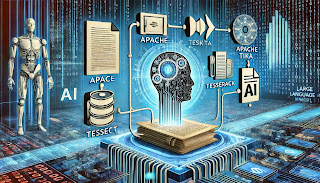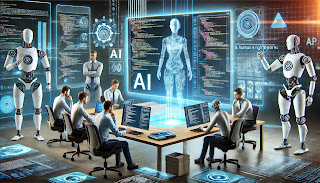The rapid evolution of Artificial Intelligence (AI) has significantly impacted various industries, including app development. Traditional app creation required extensive programming knowledge, prolonged development cycles, and dedicated teams of developers. However, the emergence of AI coders has revolutionized this process, enabling users to create apps by simply providing a single prompt. This transformative technology is democratizing app development, making it accessible to individuals and businesses with little to no coding expertise.
In this article, we will explore the concept of creating apps using AI coders, their benefits, potential use cases, and how they are reshaping the future of app development.
What Are AI Coders?
AI coders are advanced machine learning systems designed to understand human input, interpret natural language, and generate code accordingly. These systems use sophisticated algorithms trained on vast datasets of programming languages, frameworks, and development best practices. By analyzing a single prompt—often written in plain English—AI coders can automatically produce functional, deployable code for applications.
For example, you could provide a prompt like, "Create a to-do list app with user login, task management, and notification features." In response, an AI coder generates the entire app structure, backend, and frontend code, significantly reducing the effort and time required for development.
Some of the leading AI-powered tools and platforms enabling this capability include OpenAI’s Codex, Amazon’s CodeWhisperer, and tools integrated into platforms like GitHub Copilot.
How AI Coders Work
AI coders rely on large-scale language models (LLMs) to process and interpret natural language inputs. These models have been trained on a diverse range of coding data, including:
- Programming Languages: Python, JavaScript, Java, Swift, and more.
- Frameworks: React, Django, Flask, Angular, and others.
- APIs and Libraries: Popular APIs like Firebase, AWS, and libraries for specific use cases.
- Code Repositories: Public codebases from platforms like GitHub, Stack Overflow, and open-source projects.
Here’s how the process typically unfolds:
-
Input Prompt: The user provides a clear, concise description of the app or feature they want to create. For example, "Build a weather forecasting app with location tracking and a five-day forecast display."
-
Natural Language Processing (NLP): The AI coder interprets the prompt, extracting the core requirements, such as app functionality, design elements, and dependencies.
-
Code Generation: The system generates code snippets or entire programs based on the extracted requirements. This includes creating UI components, backend logic, database integrations, and API connections.
-
Testing and Debugging: Some AI coders also perform automated testing and debugging to ensure the generated code runs smoothly.
-
Deployment: Once the app is ready, users can deploy it to app stores, servers, or cloud platforms, often with minimal manual intervention.
Benefits of Using AI Coders for App Development
The ability to create apps using a single prompt offers numerous advantages:
1. Accessibility for Non-Coders
AI coders bridge the gap between technical and non-technical users. Entrepreneurs, small business owners, and individuals without programming knowledge can create functional apps by simply describing their ideas in plain language.
2. Speed and Efficiency
Traditional app development can take weeks or even months. AI coders can generate functional code in minutes, significantly accelerating the development process and enabling rapid prototyping.
3. Cost-Effectiveness
Hiring a team of developers or outsourcing app creation can be expensive. AI coders reduce costs by automating much of the development process, allowing businesses to allocate resources elsewhere.
4. Error Reduction
AI systems are designed to follow best coding practices and are less prone to human errors like syntax mistakes or inefficient coding patterns. Automated testing and debugging further enhance code quality.
5. Customization and Flexibility
AI coders allow users to refine their apps iteratively. Users can provide additional prompts or modify the initial description to make changes, add features, or improve performance.
6. Scalability
Once an app is generated, it can be easily scaled or integrated with other tools and platforms. AI coders often generate modular and reusable code, enabling seamless scalability.
Applications and Use Cases
The ability to create apps using a single prompt has diverse applications across industries. Here are some notable use cases:
1. Small Business Apps
Small businesses can leverage AI coders to create apps tailored to their needs, such as appointment booking systems, inventory management tools, or e-commerce platforms.
2. Prototyping and MVP Development
Startups can quickly develop Minimum Viable Products (MVPs) to validate their ideas and attract investors, reducing time-to-market.
3. Educational Apps
Educators and institutions can use AI coders to create customized e-learning platforms, quiz apps, or virtual classrooms.
4. Healthcare Applications
Healthcare providers can build apps for patient management, telemedicine, and appointment scheduling without needing extensive technical teams.
5. IoT Integration
AI coders can help develop apps that connect with Internet of Things (IoT) devices, such as smart home systems or wearable health trackers.
6. Entertainment and Gaming
Individuals can create simple games or multimedia apps by describing gameplay mechanics or user interactions in a prompt.
Challenges and Limitations
Despite their numerous benefits, AI coders are not without challenges. Some of the limitations include:
1. Complexity of Requirements
While AI coders excel at simple to moderately complex tasks, they may struggle with highly intricate requirements or advanced functionalities, necessitating manual intervention by experienced developers.
2. Dependence on Quality Prompts
The quality of the generated app heavily depends on the clarity and detail of the input prompt. Ambiguous or incomplete descriptions may lead to unsatisfactory results.
3. Security Concerns
AI coders may inadvertently generate insecure code, such as code with vulnerabilities to hacking or data breaches. Developers must thoroughly review and test the output to ensure security compliance.
4. Limited Creativity
AI coders rely on existing data and patterns, which may limit their ability to generate innovative or out-of-the-box solutions.
5. Ethical and Legal Issues
Since AI coders are trained on publicly available data, concerns around intellectual property rights and copyright infringement may arise.
Best Practices for Using AI Coders
To maximize the potential of AI coders and mitigate challenges, users should follow these best practices:
-
Craft Clear and Detailed Prompts: Specify the app’s purpose, target audience, features, and design preferences in the prompt.
-
Iterate and Refine: Treat the generated code as a starting point and refine it iteratively to meet specific requirements.
-
Test Thoroughly: Perform extensive testing to identify bugs, security vulnerabilities, and performance issues.
-
Collaborate with Developers: For complex projects, collaborate with experienced developers who can review and optimize the AI-generated code.
-
Stay Updated: Keep up with advancements in AI coding tools to leverage the latest features and capabilities.
Future of AI Coders in App Development
The future of AI coders looks promising, with ongoing advancements poised to make app development even more seamless and efficient. Key trends to watch include:
1. Improved NLP Capabilities
Enhanced natural language processing will enable AI coders to better understand and interpret user prompts, leading to more accurate code generation.
2. Integration with Low-Code Platforms
AI coders will likely integrate with low-code and no-code platforms, empowering users to create apps with minimal manual coding.
3. Focus on Security and Compliance
Future AI coders will prioritize secure coding practices and compliance with data protection regulations, such as GDPR and HIPAA.
4. Cross-Platform Development
AI coders will facilitate the creation of apps that work seamlessly across multiple platforms, including web, mobile, and desktop.
5. Industry-Specific Solutions
Specialized AI coders tailored to specific industries, such as healthcare, finance, and education, will emerge, offering domain-specific functionality.
Conclusion
The ability to create apps using a single prompt through AI coders is a game-changer in the tech industry. By making app development accessible, fast, and cost-effective, AI coders are empowering individuals and businesses to bring their ideas to life without requiring extensive technical expertise. While challenges remain, ongoing advancements in AI technology promise to address these limitations and unlock even greater potential.
As we move forward, AI coders will continue to shape the future of app development, enabling a new era of innovation and creativity. Whether you are a budding entrepreneur or a seasoned developer, embracing this transformative technology will undoubtedly open doors to endless possibilities.




.jpeg)
.jpeg)